Are you intrigued by the idea of wandering along the historic banks of the Tigris and Euphrates Rivers, delving into the vibrant culture of Kahramanmaraş, or exploring the rich heritage of cities like Diyarbakır and Gaziantep?
If you’re contemplating a journey to Southeastern Turkey but are uncertain about what to expect or concerned about safety, you’re in the perfect spot.
Welcome to my comprehensive guide to Southeastern Turkey, where I’ll provide you with all the insights and tips you need to make your trip memorable, safe, and hassle-free.
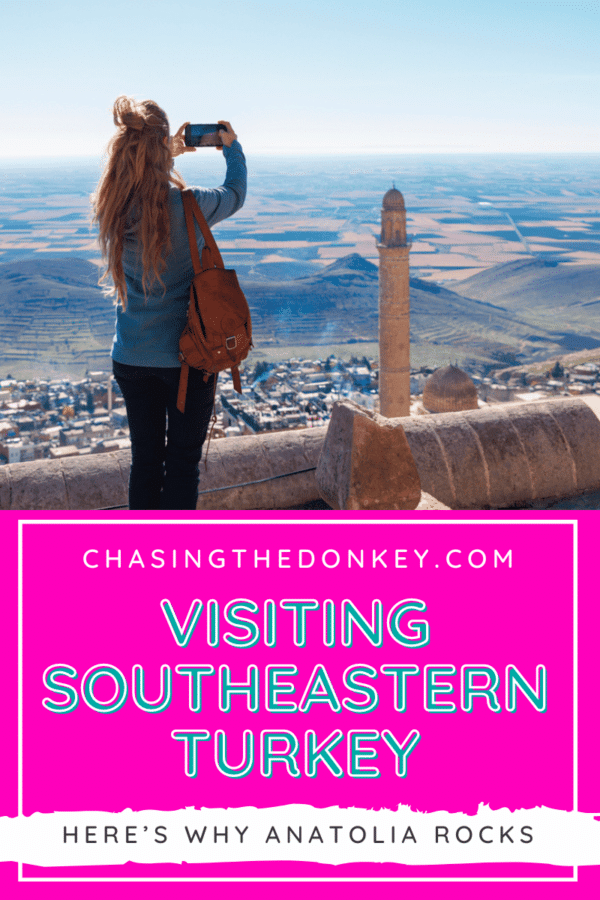
Skip Ahead To My Advice Here!
Top Destinations In The Anatolia Region
Turkey is a vast country, and there are so many different things to see. Most people think of Istanbul and the south coast beach resorts, and they are indeed unique places to visit and shouldn’t be missed. However, if you skip the more traditional parts of the country, you’re missing out.
The south coast resorts aren’t an accurate representation of traditional Turkish life. They’re very Westernized and touristic, which means they don’t show you the more cultural side of the country.
Of course, you’ll get an idea and be able to experience some things, but you won’t indeed be able to say that you’ve experienced traditional Turkish life. Even the food isn’t the real deal.
So, if you want to say you’ve “Been there, done that,” you need to explore a little further afield.
The capital city of Ankara will undoubtedly show you more of the traditional way of life, as well as the other towns and cities in the interior of the country, such as Konya.
However, if you really want to explore and go a little off the beaten track, why not head to southeast Turkey?
How Is Southeastern Turkey Different
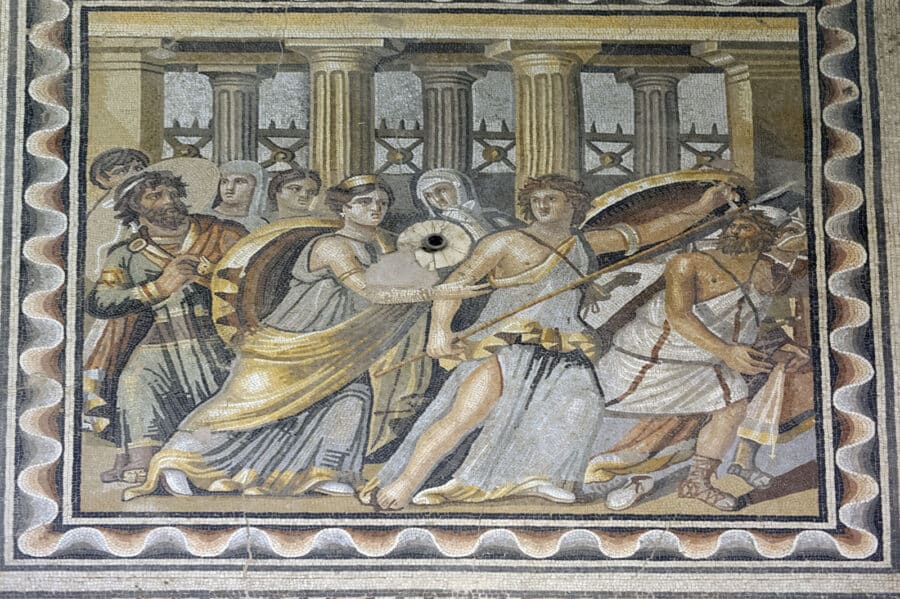
The difference between southeast Turkey and the rest of the country lies in how truly traditional it is. This is a little different from everywhere else, and while many of the customs are the same, some additions make it a real melting pot of old and new, traditional and modern.
The Southeast of Turkey is a more conservative area, so there are some things you’ll need to bear in mind if you’re heading off to explore. But that shouldn’t put you off. As long as you know about the area and what to wear to avoid drawing unwanted attention (more on that later), you’ll have a truly enriching experience, and you’ll meet so many welcoming and wonderful people who will do everything to make your visit as special as possible.
Of course, that’s not to say that the regular touristic parts of the country are less special; everything about Turkey is special. But if you’re someone who wants an adventure, the Southeast of Turkey will give it to you, and there are so many ancient sites to explore and delicious foods to try.
It’s just different. And different in a good way.
Is Southeast Anatolia Safe
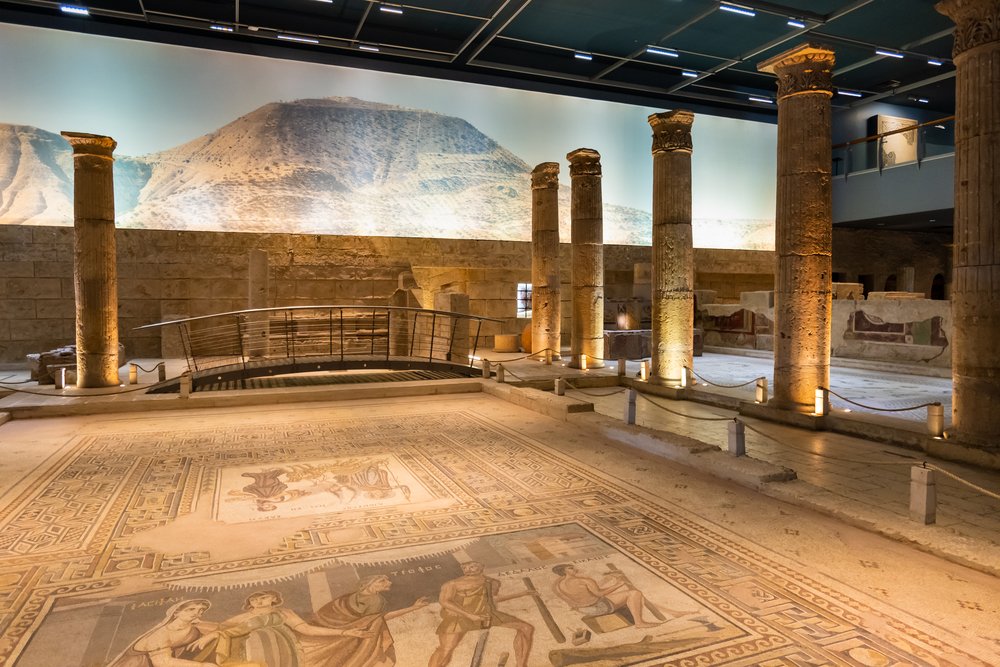
This is a common question, and I’ll do my best to answer it as accurately as I can. The truth is that the southeast part of Turkey has experienced some security concerns in the past due to regional conflicts and incidents related to terrorism. This is a predominantly Kurdish part of the country, and there have been clashes in the past.
It would be wrong to say that all the troubles are now over and nothing will ever happen again because we don’t know, and there are still brewing tensions between different groups in this region.
The southeast part of the country also shares a land border with Syria, which can sometimes exacerbate tensions near the border.
You may also remember that in February 2023, a huge earthquake devastated parts of Sanliurfa, Adana, Gaziantep, Hatay, and Diyarbakir, key cities in this part of the country.
But it’s not all doom and gloom.
It’s important to note that many areas in southeastern Turkey are considered safe for travel. Popular tourist destinations like Gaziantep, Sanliurfa (Urfa), Mardin, and Diyarbakir have seen increased stability in recent years, and they’re fantastic places to go.
So, while it would be wrong to say that this part of Turkey is 100% safe and totally fine to visit without concerns, it’s certainly not somewhere you should automatically avoid either. Nowhere in the world is 100% safe, even if on a private tour.
This brings us to the subject of lone female travelers. Again, it’s not unsafe, but you do have to be careful. Personally, I’d cover up, and while you don’t have to cover your head in this part of the country if you don’t want to, I think I would avoid any unwanted attention.
It’s also a good idea not to walk around alone at night and to stick to the main central areas. But let’s be honest, that’s standard advice for anywhere, right?
Of course, that doesn’t mean you shouldn’t still be careful. This is a conservative part of the country, and you should bear that in mind when you decide what to wear, how to act, and where to go.
To help you out, let’s explore a bit further.
What To Wear When Visiting Southeastern Anatolia
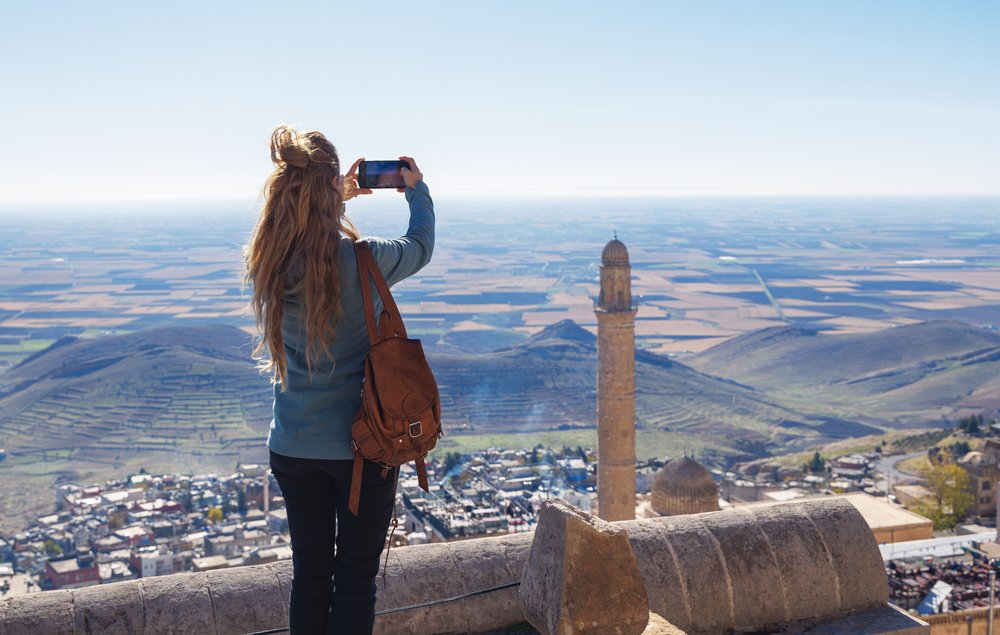
When visiting Southeastern Turkey, it’s important to consider the local culture and climate. Here are some suggestions for what to wear during your time:
Modest Clothing
As southeast Turkey is a conservative region, it’s best to dress modestly out of respect for the local customs. Opt for clothing that covers your shoulders, chest, and legs.
While you don’t necessarily have to cover your head as a woman, you might still want to consider it.
Lightweight Fabrics
The region can get quite hot during summer months, so choose lightweight and breathable fabrics like cotton or linen to stay cool and comfortable.
Sun Protection
Don’t forget to bring a wide-brimmed hat or a scarf to protect yourself from the sun’s rays. Sunglasses and sunscreen are also essential.
Comfortable Shoes
Since you’ll likely be walking a lot while exploring southeastern Turkey’s beautiful landscapes and historical sites, make sure you have comfortable shoes suitable for uneven terrain.
Layering Options
In some areas of southeast Turkey, temperatures can drop in the evenings or during certain seasons. It’s advisable to bring layers such as light sweaters or jackets that you can quickly put on or take off as needed.
Respectful Attire For Religious Sites
If you plan on visiting mosques or other religious sites, both men and women should have clothing that covers their arms and legs out of respect.
As a woman, you will have to cover your head if you’re going into the mosque, and both men and women will need to take off their shoes.
Brands We Use And Trust
Tips When Visiting The South East Part Of Türkiye

Do Your Research Beforehand
Know what you want to see in your itinerary, how to get there, and where you’ll stay. Being organized will cut down on any issues, and you’ll have a much better time.
Check The News Regularly
As I mentioned earlier, this part of the country has had safety concerns in the past, so it’s good common sense to keep an eye on the news.
Let Someone Know Where You’re Going
Let a family member or friend back home know where you’re going and when.
Purchase An eSIM
An eSIM will ensure you’ll have Internet access at all times, and you can check in with people back home and check the weather, news, and maps. While Wi-Fi is widely available in this part of the country, it can be sketchy at times. Having data will solve that problem.
Keep A Scarf Handy
Keep a pashmina in your bag in case you choose to go into a mosque or feel more comfortable covered up.
Think About Tours
In this part of the country, you will find many organized tours to the main sights, including walking tours around the key cities.
These are good ways to learn more from a knowledgeable guide, meet other like-minded travelers, and increase your safety factor.
Stay Somewhere Central
While it might be a tiny bit more expensive to stay in a central hotel or hostel, it’s a much better idea because it stops you from having to walk around in residential or quieter areas, particularly at night.
What Is The Weather Like In South Eastern Turkey
The weather in Southeastern Turkey can vary throughout the year. Here’s a general overview of the average weather conditions:
Spring (March-May)
Spring in southeast Turkey is generally mild and pleasant, with temperatures ranging from 10°C (50°F) to 20°C (68°F). It’s a great time to visit as the landscapes are waking up from the winter freeze, and the flowers are blooming.
Summer (June – August)
Summers in southeast Turkey can be pretty hot, with temperatures often exceeding 30°C (86°F) and occasionally reaching up to 40°C (104°F). It’s advisable to stay hydrated and seek shade during the hottest parts of the day.
Autumn (September – November)
Autumn brings cooler temperatures ranging from 15°C (59°F) to 25°C (77°F), making it an ideal time for outdoor activities. The region also experiences occasional rainfall during this season.
Winter (December – February)
Winters in southeast Turkey can be cold, especially at higher altitudes. Temperatures range from around -5 °C (23°F) to 10°C (50 °F). Snowfall is common in mountainous areas, creating beautiful winter landscapes.
Why Is South Eastern Anatolia So Great
Southeastern Turkey is a beautiful region known for its rich history, diverse culture, and stunning landscapes. But of course, the rest of Turkey is gorgeous, too. So, what makes this part of the country stand out?
The history in this part of the country dates back to the earliest stages of civilization, and the architecture is simply mind-blowing; just walking around will show you different styles and centuries-old buildings. This is such a diverse part of the country that it will show you different sides to explore, which is precisely what makes it so special.
Historical Sites
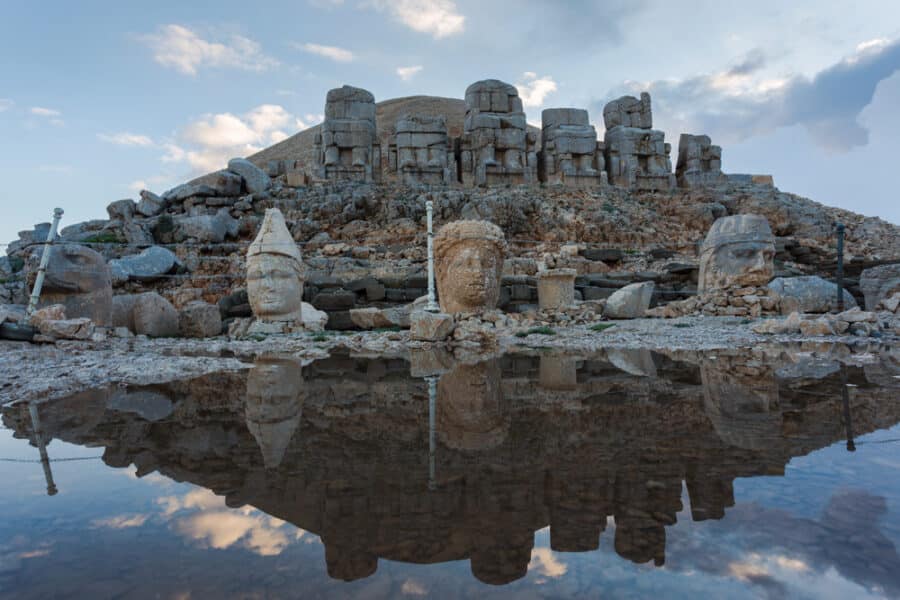
Turkey’s Southeast is home to many ancient cities and archaeological sites. One of the most famous is Göbekli Tepe, considered the world’s oldest temple complex, dating back over 11,000 years.
Other notable sites include the top of Mount Nemrut with its giant statues, Harran’s beehive-shaped houses, and the ancient city of Mardin.
Cultural Diversity
The region is known for its cultural diversity due to its proximity to neighboring countries like Iran, Syria, and Iraq. This diversity can be seen in architecture, cuisine, music, and traditional clothing.
Hospitality
Turkish people are renowned for their warm hospitality and friendliness towards visitors. You can expect to be welcomed with open arms by locals who will go out of their way to make you feel at home.
Cuisine

The region boasts a delicious culinary tradition influenced by various cultures throughout history.
Don’t miss out on trying traditional dishes like kebabs (such as Adana kebab), lahmacun (Turkish pizza), baklava (sweet pastry), and çiğ köfte (spicy raw meatballs).
However, if you don’t like spicy food, you need to learn the word for “not-spicy” – acisiz. This part of the country is known for food with added heat!
Outdoor Activities
If you enjoy outdoor activities, southeastern Turkey has plenty to offer. You can go hiking in the Taurus Mountains or explore national parks such as Mount Ararat or Hasankeyf Castle.
Local Handicrafts
The region is known for its traditional handicrafts, such as carpets from Gaziantep or Kilims from Mardin, which make great souvenirs to take back home—especially if you haggle for them at a local bazaar.
Discover The Best Cities & Towns In Southeastern Turkey
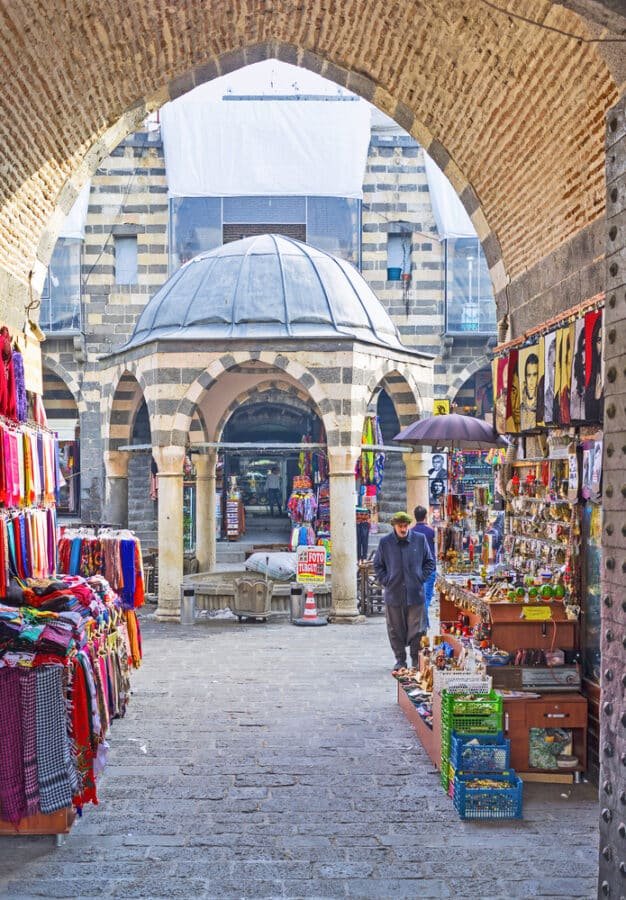
Gaziantep
Gaziantep is a city rich in history and renowned for its mouth-watering cuisine. Often referred to as the culinary capital of Turkey, it is home to world-famous dishes like baklava and kebabs.
One of the city’s most prominent landmarks is the Gaziantep Castle, which stands as a testament to the city’s long history, dating back to the Roman period. Walking through the streets of Gaziantep, you’ll also encounter numerous museums, including the Zeugma Mosaic Museum, housing some of the most well-preserved Roman mosaics in the world.
Şanlıurfa
Known as the city of prophets, Şanlıurfa (often called simply Urfa) is a treasure trove of historical and religious significance.
The city is home to Göbekli Tepe, the oldest known temple complex in the world, dating back to 9600 BCE, a site that is rewriting the history of civilization. Another key attraction is the Cave of Abraham, where the prophet is believed to have been born. As you explore the bustling streets, don’t miss the sacred Balıklıgöl (Fish Lake), a place tied to the story of Abraham and King Nimrod.
Diyarbakır
Diyarbakır is one of the largest and most culturally rich cities in Southeast Turkey. Once part of the Roman Empire, the city is now famous for its ancient city walls and some of the longest and most well-preserved fortifications in the world.
Within its walls, you’ll find landmarks like the Ulu Mosque, one of the oldest mosques in Turkey, and the nearby ancient town of Hasankeyf, which sits along the Tigris River. This city is the heart of the region and a key stop for anyone exploring Southeast Turkey.
Top Places To Visit In Southeastern Turkey
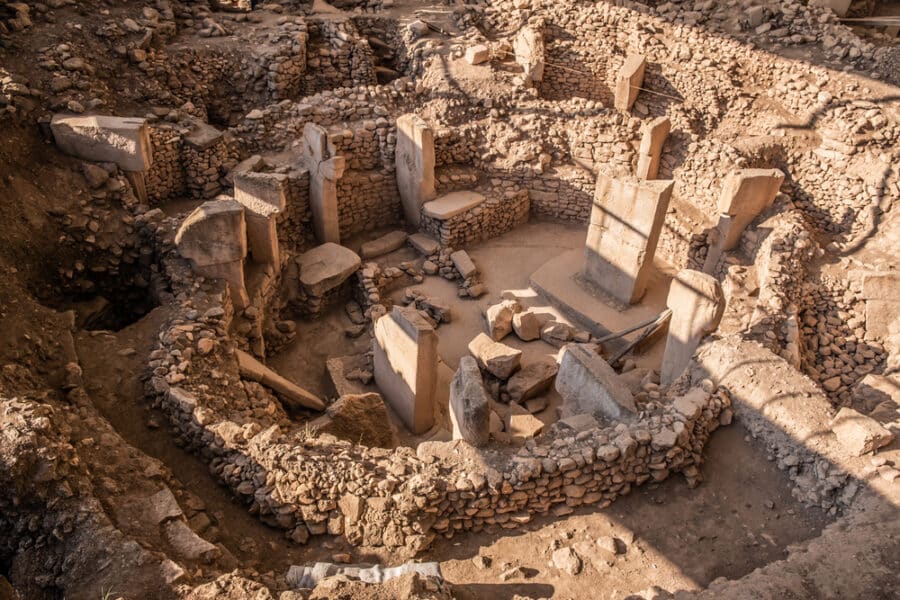
Now you know all about southeast Turkey, the itinerary options available, why it’s so great, what attractions to explore, how to stay safe, and the main towns and cities, let’s give you some ideas of what to put on your must-visit list.
Certainly! Here’s the revised list with your requested modifications:
- Mount Nemrut: a UNESCO World Heritage Site featuring ancient statues and a stunning sunrise view
- Göbekli Tepe: the world’s oldest known temple complex, dating back over 11,000 years
- Harran: an ancient city with beehive-shaped houses and remnants of a grand mosque
- Mardin City Centre: a picturesque city known for its historic architecture and stunning views of the Mesopotamian plains
- Hasankeyf: an ancient town on the Tigris River with cave dwellings, ruins, and a medieval bridge
- Diyarbakır City Walls: massive stonework walls surrounding the old city of Diyarbakır, offering panoramic views
- Urfa (Şanlıurfa): known as the “City of Prophets,” it has historical sites like Balıklıgöl (Pool of Sacred Fish) and Abraham’s Cave
- Zeugma Mosaic Museum: houses an impressive collection of Roman mosaics discovered in Zeugma archaeological site near Gaziantep
- Gaziantep Castle (Gaziantep Kalesi): an ancient fortress offering panoramic views over Gaziantep city center
- Dara Ancient City: ruins of an important Roman-Byzantine border fortress near Mardin with underground tunnels to explore
- Cendere Bridge (Septimius Severus Bridge): an ancient Roman bridge spanning the Cendere Stream near Adıyaman
- Halfeti Village & Rumkale Fortress: a charming village submerged under water due to a dam project, along with a nearby Byzantine castle
- Tur Abdin Region Monasteries: ancient monasteries such as Mor Gabriel Monastery (one of the oldest surviving Syriac Orthodox monasteries in the world) or Deyrulzafaran Monastery that showcase Syriac Christian heritage
- Hasankeyf Caves: a network of natural and artificial caves in Hasankeyf, once used as dwellings and storage areas
- Malabadi Bridge: an impressive medieval bridge near the town of Silvan, known for its unique architecture
- Mount Ararat: the highest peak in Turkey, believed to be the resting place of Noah’s Ark according to biblical accounts
- Mardin Museum (Mardin Müzesi): exhibits artifacts from different periods, including Assyrian and Roman eras
- Midyat Old Town: a well-preserved historic district with traditional stone houses adorned with intricate carvings
- Deyrulzafaran Monastery: an ancient Syriac Orthodox church and monastery near Mardin known for its beautiful frescoes and religious significance
- Tigris River Boat Tours: enjoy a scenic boat ride along the Tigris River, offering breath-taking views of the surrounding landscapes
This is not an exhaustive list, but can you see how much history, nature, and culture there is to see in this part of the country?
Food To Try In Turkey’s Southeastern Region
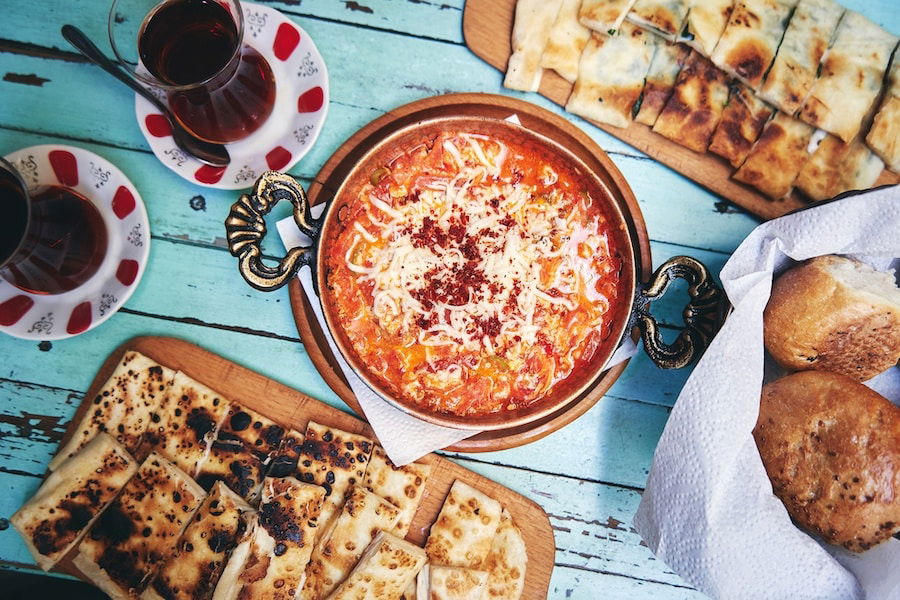
Turkish food, in general, is delicious. I mean, encountering such unique flavors is like something else entirely. But in the southeast part of the country, it goes to another level.
Gaziantep, in particular, is known for its street food, and the whole region loves spicy food. The produce here is fresh and delicious, and with centuries of cooking passed down through generations, you can be sure of a delicious meal no matter where you go.
Of course, you’ll find many of these foods all over the country, but there’s just something different about them in this region. Tastier? Perhaps!
So, what foods should you put on your must-try list when you visit southeast Turkey?
- Lahmacun: thin, crispy flatbread topped with minced meat, vegetables, and herbs
- Şiş Kebab: skewered and grilled marinated chunks of meat (usually lamb or chicken)
- Kadayıf: a sweet pastry made of shredded phyllo dough soaked in syrup and filled with nuts
- Dolma: stuffed vegetables like grape leaves or bell peppers filled with a mixture of rice, ground meat, and spices
- Çiğ Köfte: raw minced meat mixed with bulgur wheat, spices, and herbs; often served as a wrap or in lettuce leaves
- Şırnak Tava: a hearty dish made with lamb or beef cooked slowly in a tomato-based sauce along with potatoes and onions
- Ayran: a refreshing yogurt-based drink that is slightly salty and often enjoyed alongside meals
- Pistachio baklava: layers of thin pastry filled with nuts (usually pistachios) and sweetened with syrup or honey
- Pide: similar to pizza but typically boat-shaped; topped with various ingredients like cheese, ground meat, or vegetables
- Mardin Tarhana Soup: a tangy soup made from fermented grains mixed with yogurt, tomatoes, onions, mint leaves, and spices
- Urfa Kebabı: spicy grilled kebabs seasoned heavily with Urfa pepper flakes for a unique smoky flavor
- Biryani Rice Pilaf: fragrant rice cooked in broth along with various spices like cinnamon sticks and cumin seeds; often served as an accompaniment to main dishes
- Menemen: a delicious breakfast dish consisting of scrambled eggs cooked together with tomatoes, peppers, and onions, a must-try for anyone visiting the region
- Simit: sesame-covered bread rings that are crunchy on the outside but soft on the inside; often enjoyed with tea
- Manti: small dumplings filled with ground meat, typically served with garlic yogurt and drizzled with melted butter and paprika
- Turkish coffee: kick back and relax at a café and enjoy the best coffee you will have in your life
Move This Adventure To Your Inbox & Get An Instant Freebie

No spam. Unsubscribe at any time.
How To Get To Southeastern Turkey

The southeastern towns and cities, such as Antalya, Bodrum, Marmaris, Izmir, and Istanbul, are very far away from the main tourist parts of Turkey. For that reason, the most sensible way to get to southeast Turkey is to fly.
You can fly to Istanbul and then get a domestic flight to Diyarbakir Airport. From there, you can take regional buses to the town or city you want to get to.
For instance, Batman is 1.5 hours away from Diyarkbakir, and Mardin is around the same distance. However, if you want to go to Hatay, you’d be better off flying there from Istanbul, as it’s pretty far from Diyarbakir. The same advice goes for Gaziantep.
So, Should You Visit Southeastern Turkey?
Now you know everything there is to know, what do you think? Personally, I believe this beautiful and cultural part of the country should not be missed, but there certainly are some considerations you need to take into account before you go.
It is very different from Marmaris, Antalya, Bodrum, etc., and still very different from Istanbul. But it’s different in a way that will take your breath away for all the right reasons. The history and culture here is like nowhere else, and you’ll be glad you went.
The only thing to remember is planning. This isn’t an area you can go to and just ‘wing it.’ You need to know what you want to see and when.
With careful planning, you’ll be able to enjoy your off-the-beaten-track adventure, and you’ll be 100% happy with your decision to travel to this understated and stunning part of the country.
- Best Hotels In Cappadocia, Turkey
- Best Restaurants In Bodrum
- Best Types Of Turkish Kebab To Try
- Best Places To Visit In Turkey For Every Type Of Traveler
- How To Make Turkish Coffee
- Hotels In Cappadocia, Turkey
- Best Food Tours In Istanbul
- What To Pack For Turkey
- 5 Reasons To Visit Gallipoli, Turkey
- How To Get From Istanbul To Cappadocia
- Cappadocia Hot Air Ballon Ride Tips
- Greek Island Day Trip From Southern Turkey
- Turkish Hammam Tips To Know Before You Go
- Tips For Traveling Turkey On A Budget
- Guide To The Ancient City Of Dara

